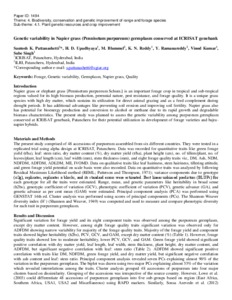Genetic variability in Napier grass (Pennisetum purpureum) germplasm conserved at ICRISAT genebank
Abstract
Napier grass or elephant grass (Pennisetum purpureum Schum.) is an important forage crop in tropical and sub-tropical regions valued for its high biomass production, perennial nature, pest resistance, and forage quality. It is a unique grass species with high dry matter, which sustains its utilization for direct animal grazing and as a feed complement during drought periods. It has additional advantages like preventing soil erosion and improving soil fertility. Napier grass also has potential for bioenergy production and conversion to alcohol or methane due to its rapid growth and degradable biomass characteristics. The present study was planned to assess the genetic variability among purpureum germplasm conserved at ICRISAT genebank, Patancheru for their potential utilization in development of forage varieties and bajranapier hybrids

